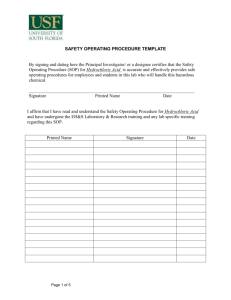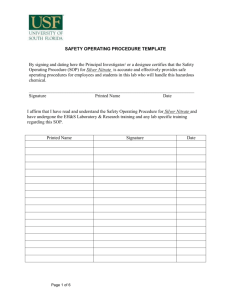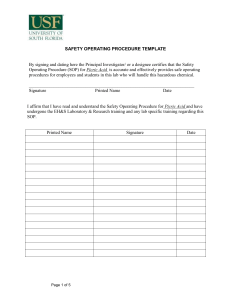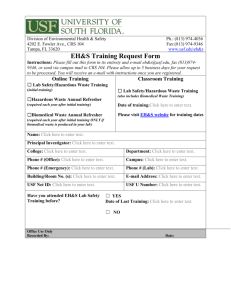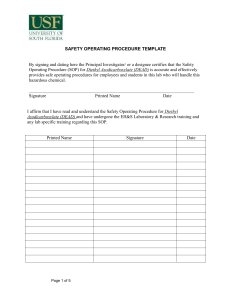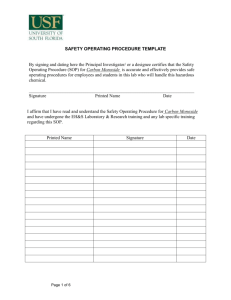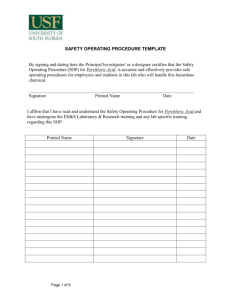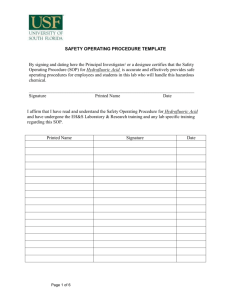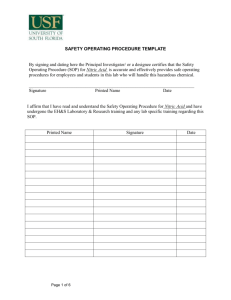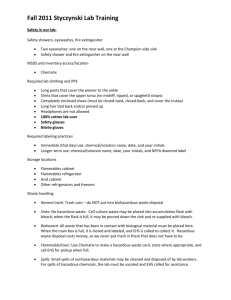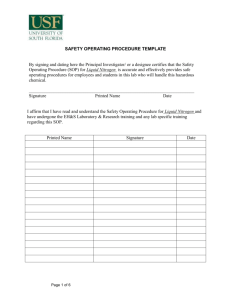Sodium Azide - University of South Florida
advertisement
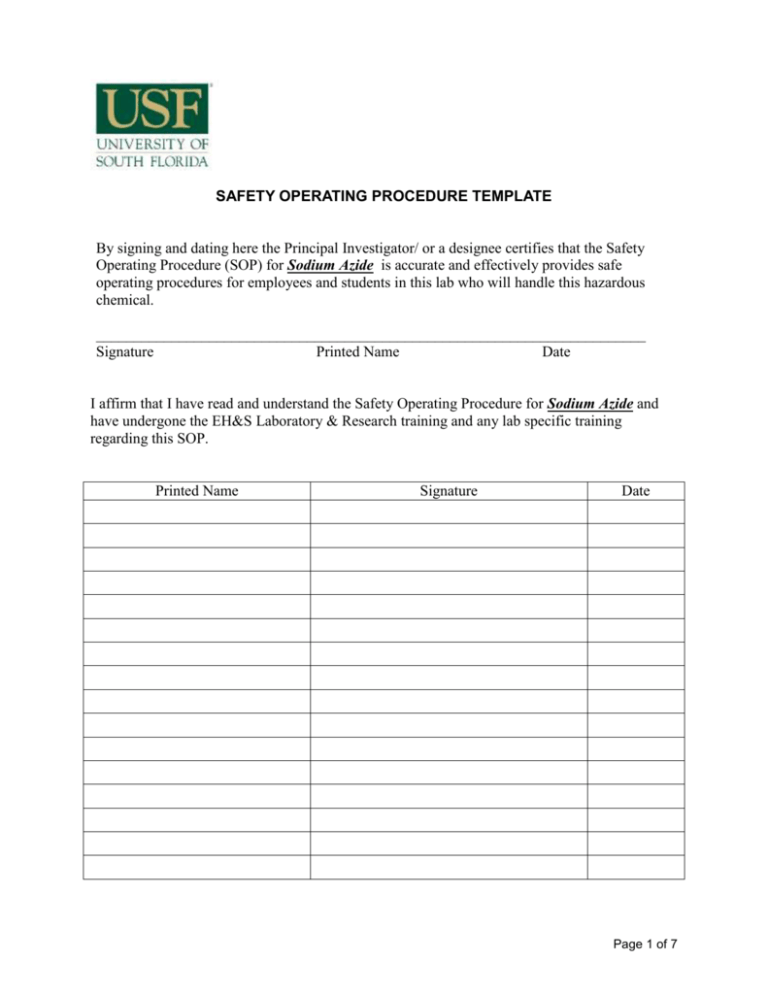
SAFETY OPERATING PROCEDURE TEMPLATE By signing and dating here the Principal Investigator/ or a designee certifies that the Safety Operating Procedure (SOP) for Sodium Azide is accurate and effectively provides safe operating procedures for employees and students in this lab who will handle this hazardous chemical. _________________________________________________________________________ Signature Printed Name Date I affirm that I have read and understand the Safety Operating Procedure for Sodium Azide and have undergone the EH&S Laboratory & Research training and any lab specific training regarding this SOP. Printed Name Signature Date Page 1 of 7 CONTACT INFORMATION Chemical Name: Sodium Azide Building/Room Number: Date of Creation/Revision Principal Investigator: (The PI, Lab Supervisor, or Autonomous Researcher) Emergency Phone Number: HAZARD SUMMARY List all physical and health hazards associated with the chemical in this SOP. Examples of potential hazards include: toxicity, reactivity, flammability, corrosivity, pressure, etc. Potential physical and health hazards associated with the use of this chemical include: OSHA Hazards: Target Organ Effect, Highly toxic by ingestion, Highly toxic by skin absorption Target Organs: Heart, Central nervous system, Brain. Other hazards which do not result in classification: Rapidly absorbed through skin. Potential Health Effects: May be harmful if inhaled. May cause respiratory tract irritation. May be fatal if absorbed through skin. May cause skin irritation. May cause eye irritation to eyes. May be fatal if swallowed. Sodium Azide may react with lead and copper plumbing to form highly explosive metal azides. Sodium Azide will react violently with nitric acid, bromine, carbon disulfide, dimethylsulfate, and heavy metals including, copper and lead. Contact with acids liberates very toxic gas. NFPA Rating: Health hazard: 4 Fire: 0 Reactivity Hazard: 0 SPECIAL HANDLING AND STORAGE REQUIREMENTS Describe special handling and storage requirements for this hazardous chemical in your laboratory, i.e. restricted access to chemical, inclusion of designated areas to limit and minimize possible sources of exposure to these materials. The entire laboratory, a portion of the laboratory, or a laboratory fume hood or bench may be considered a designated area. Special handling and storage requirements for this chemical include: Avoid contact with skin and eyes Page 2 of 7 Wear latex or nitrile gloves and safety goggles Avoid formation of dust and aerosols Provide appropriate exhaust ventilation at places where dust is formed Work inside a fume hood Use non-metal utensils Conditions for safe storage: Keep container tightly closed in a dry and well-ventilated place Never allow product to get in contact with water during storage Do not store near acids Store in a plastic container Use a secondary container ENGINEERING AND VENTILATION CONTROLS Include requirements for specific engineering/ventilation controls for this specific chemical, i.e. fume hood. If the process does not permit the handling of such materials in a fume hood, the lab personnel should contact Environmental Health and Safety at x4-4036 for review the adequacy of ventilation measures. Handling processes should be designed to minimize the potential for splash, splatter, or other likely scenarios for accidental contact. The handling of this chemical must be conducted in a fume hood. Additional engineering/ventilation controls for the handling of this chemical include: Handle in a chemical fume hood, using non-metal utensils PERSONAL PROTECTIVE EQUIPMENT Include specific personal protective equipment required for the handling of this chemical. See the following references: 1. The USF Hazardous Inventory Tracking System (HITS) provides access to MSDS. 2. A glove compatibility chart provides specific information on the type of safety gloves that should be used based on the hazards of specific chemicals. 3. The following EH&S webpage provides links to glove manufacturers as well as other PPE selection resources, http://usfweb2.usf.edu/eh&s/labsafety/links.html. At minimum, safety glasses, lab coat, and gloves are to be worn when using this hazardous chemical. Additional PPE Requirements for the handling of this chemical include: ☒ appropriate clothing (long pants, close-toed shoes) ☒ ☒ ☒ ☐ ☐ gloves; indicate type: Nitrile safety goggles face shield flame-resistant lab coats other:__________________________ Hand Protection: Handle with gloves. Gloves must be inspected prior to use. Use proper glove removal technique (without touching glove's outer surface) to avoid skin contact with this product. Dispose of contaminated gloves after use in accordance with applicable laws and good laboratory practices. Wash and dry hands. Page 3 of 7 Immersion Protection: Material: Nitrile rubber Minimum layer thickness: 0.11 mm Break through time: 480 min Splash Protection: Material: Nitrile rubber Minimum layer thickness: 0.11 mm Break through time: 480 min Eye Protection: Face shield and safety glasses. Use equipment for eye protection tested and approved under appropriate government standards such as NIOSH (US) or EN 166(EU). Skin and Body Protection: Complete suit protecting against chemicals, The type of protective equipment must be selected according to the concentration and amount of the dangerous substance at the specific workplace. Hygiene Measures: Avoid contact with skin, eyes and clothing. Wash hands before breaks and immediately after handling the product. If the use of an N95, half mask, or full face respirator is requested, the individual and/or their supervisor must first contact Environmental Health & Safety for a consultation to determine if respirator use is necessary. If EH&S determines the use of a respirator is necessary, the individual must participate in the University’s respirator program. This includes a medical evaluation; respirator fit test, and training. EMERGENCY PROCEDURES If a there is a spill involving an extremely hazardous chemical, emergency responders should be contacted immediately. Dial 911 during and after normal business hours to contact the local emergency responders for your area and provide detail information to the emergency responders including chemical name, volume, hazards, spill location, and any injuries incurred. Building occupants can be notified of a building evacuation through the activation of a fire alarm pull station. Personnel: If lab personnel are exposed to an extremely hazardous chemical, call 911 immediately. Remove any contaminated clothing, and IMMEDIATELY flush contaminated skin with water for at least 15 minutes following any skin contact. For eye exposures, IMMEDIATELY flush eyes with water for at least 15 minutes. Consult MSDS for guidance on appropriate first aid. Where medical attention is required, ensure to bring along MSDS(s) of chemical(s) to aid medical staff in proper diagnosis and treatment. Fire and Emergency Evacuation Procedures: In case of fire or emergency situation, call 911 and or use emergency blue phone immediately to notify the fire emergency services and campus police. Immediately evacuate the building via the nearest exit when the fire alarm is activated. If unable to evacuate due to a disability, shelter in the area of rescue / refuge, typically a stairwell landing, and wait for assistance from drill volunteers or emergency responders. Instruct visitors and students to evacuate and assist them in locating the nearest exit. Do not use elevators to exit the building during an evacuation as they may become inoperable. Carry only those personal belongings that are within the immediate vicinity. Close doors to limit the potential spread of smoke and fire. Terminate all hazardous operations and power off equipment. Close all hazardous materials containers. Page 4 of 7 Remain outside of the building until the building is released for reentry. Do not restrict or impede the evacuation. Convene in the designated grassy gathering area and await instruction from emergency responders or drill volunteers. Avoid parking lots. Report fire alarm deficiencies, (e.g., trouble hearing the alarm) to facilities personnel for repair. Notify evacuation drill volunteers or emergency responders of persons sheltering in the areas of rescue/ refuge. Never assume that an alarm is a “false alarm”. Treat all fire alarm activations as emergencies. Get out of the building! Personal Precautions: Wear respiratory protection Avoid dust formation Avoid breathing vapors, mist or gas Ensure adequate ventilation Evacuate personnel to safe areas Avoid breathing dust Environmental Precautions: Prevent further leakage or spillage if safe to do so Do not let product enter drains, discharge into the environment must be avoided Methods and materials for containment and cleaning up: Pick up and arrange disposal without creating dust Sweep up and shovel Do not flush with water Keep in closed, plastic containers for disposal FIRST AID MEASURES: Consult a physician - show this safety data sheet to the doctor in attendance Move out of dangerous area If Inhaled: If breathed in, move person into fresh air If not breathing, give artificial respiration Consult a physician In Case of Skin Contact: Wash off with soap and plenty of water Take victim immediately to hospital In Case of Eye Contact: Flush eyes with water as a precaution If Swallowed: Never give anything by mouth to an unconscious person Rinse mouth with water The Laboratory/Studio and Field Incident Report form is to be completed by the Lab Manager/Teaching Assistant/Instructor for any incident that occurs in any University of South Florida affiliated teaching or Page 5 of 7 research laboratory/studio or field research project. An incident means any unplanned event within the scope of a procedure that causes, or has the potential to cause, an injury or illness and/or damage to equipment, buildings, or the natural environment. Please fill out the online Laboratory/Studio and Field Incident Report form below and submit to Environmental Health & Safety within 24 hours of the incident. Due to medical privacy concerns, no personal identifying information of the person involved in the incident shall be entered or submitted with the form. http://usfweb2.usf.edu/eh&s/labsafety/LabIncident.html Page 6 of 7 WASTE DISPOSAL All chemical waste generated within USF System laboratories are considered hazardous waste and must be disposed of as hazardous waste in accordance with USF Hazardous Waste Management Procedure, the EPA, and the DEP. The USF Hazardous Waste Management Procedure can be found using the following link, http://compass.custhelp.com/app/answers/detail/a_id/1118/kw/hazardous%20waste. Sodium Azide is an EPA P-listed chemical. It is acutely hazardous in small amounts. Even the empty container must be disposed of through EH&S as hazardous waste. TRAINING REQUIREMENTS All individuals working with chemicals in USF laboratories must take EH&S’s Laboratory & Research Safety Training. To register for Laboratory & Research Training, please use the following link, http://usfweb2.usf.edu/eh&s/labsafety/tmaterials.html. However, the use of this chemical may warrant additional safety training per the PI, EH&S, or an authorizing unit such as the Biosafety or Radiation Safety programs. Additional training requirements are listed below. Training Requirements: ☒ Laboratory & Research Safety Training (EH&S) ☒ Research-specific Training (PI) ☐ Other _____________________________________________________________ PRIOR APPROVALS ☐ The handling of this chemical requires prior approval from the PI/designee. ☐ The handling of this chemical does not require prior approval from the PI/designee. Approval Signature (if required by PI) _________________________________________________________ Page 7 of 7
